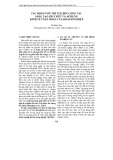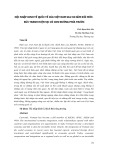
Chapter 33
Aggregate Demand and Aggregate Supply
TRUE/FALSE
1. According to classical macroeconomic theory, changes in the money supply change nominal but not real
variables.
ANS: T DIF: 1 REF: 33-2
NAT: Analytic LOC: Aggregate demand and aggregate supply
TOP: Classical economics MSC: Definitional
2. Because economists understand what things change GDP, they can predict recessions with a fair amount of
accuracy.
ANS: F DIF: 1 REF: 33-1
NAT: Analytic LOC: Aggregate demand and aggregate supply
TOP: Economic fluctuations MSC: Analytical
3. Most macroeconomic variables that measure some type of income, spending, or production fluctuate closely
together.
ANS: T DIF: 1 REF: 33-1
NAT: Analytic LOC: Aggregate demand and aggregate supply
TOP: Economic fluctuations MSC: Interpretive
4. Like real GDP, investment fluctuates, but it fluctuates much less than real GDP..
ANS: F DIF: 1 REF: 33-1
NAT: Analytic LOC: Aggregate demand and aggregate supply
TOP: Economic fluctuations | Investment MSC: Definitional
5. When output rises, unemployment falls.
ANS: T DIF: 1 REF: 33-1
NAT: Analytic LOC: Aggregate demand and aggregate supply
TOP: Economic fluctuations | Unemployment MSC: Definitional
6. An increase in the money supply causes output to rise in the long run.
ANS: F DIF: 1 REF: 33-2
NAT: Analytic LOC: Aggregate demand and aggregate supply
TOP: Monetary neutrality MSC: Definitional
7. Most economists believe that classical theory describes the world in the short run but not in the long run.
ANS: F DIF: 1 REF: 33-2
NAT: Analytic LOC: Aggregate demand and aggregate supply
TOP: Classical dichotomy MSC: Interpretive
8. A change in the money supply changes only nominal variables in the long run.
ANS: T DIF: 1 REF: 33-2
NAT: Analytic LOC: Aggregate demand and aggregate supply
TOP: Monetary neutrality MSC: Definitional
9. The explanations for the slopes of the aggregate demand and short-run aggregate supply curves are the same
as the explanations for the slopes of demand and supply curves for specific goods and services.
ANS: F DIF: 1 REF: 33-2
NAT: Analytic LOC: Aggregate demand and aggregate supply
TOP: Aggregate demand slope | Short-run aggregate supply slope
MSC: Definitional
136

137 Chapter 33/Aggregate Demand and Aggregate Supply
10. The aggregate-demand curve shows the quantity of domestic goods and services that households, firms, the
government, and customers abroad want to buy at each price level.
ANS: T DIF: 2 REF: 33-2
NAT: Analytic LOC: Aggregate demand and aggregate supply
TOP: Aggregate-demand curve MSC: Definitional
11. A decrease in the price level makes consumers feel wealthier, so they purchase more. This logic helps explain
why the aggregate demand curve slopes downward.
ANS: T DIF: 1 REF: 33-3
NAT: Analytic LOC: Aggregate demand and aggregate supply
TOP: Wealth effect MSC: Analytical
12. Other things the same, a decrease in the price level makes the interest rate decrease, which leads to a
depreciation of the dollar in the foreign-currency exchange.
ANS: T DIF: 2 REF: 33-3
NAT: Analytic LOC: Aggregate demand and aggregate supply
TOP: Wealth effect | Exchange-rate effect MSC: Analytical
13. The exchange-rate effect is the idea that a higher U.S. price level causes the value of the dollar to increase in
foreign exchange markets, and this effect contributes to the downward slope of the aggregate-demand curve.
ANS: T DIF: 2 REF: 33-3
NAT: Analytic LOC: Aggregate demand and aggregate supply
TOP: Aggregate demand slope MSC: Interpretive
14. The downward slope of the aggregate demand curve is based on logic that as the price level rises,
consumption, investment, and net exports all fall.
ANS: T DIF: 2 REF: 33-3
NAT: Analytic LOC: Aggregate demand and aggregate supply
TOP: Aggregate demand slope MSC: Interpretive
15. Aggregate demand shifts to the left if the money supply increases.
ANS: F DIF: 1 REF: 33-3
NAT: Analytic LOC: Aggregate demand and aggregate supply
TOP: Aggregate demand shifts | Monetary policy MSC: Applicative
16. A decrease in the money supply causes the interest rate to rise so that investment falls.
ANS: T DIF: 2 REF: 33-3
NAT: Analytic LOC: Aggregate demand and aggregate supply
TOP: Aggregate demand shifts | Money supply MSC: Analytical
17. If speculators bid up the value of the dollar in the market for foreign-currency exchange, U.S. aggregate
demand would shift to the left.
ANS: T DIF: 2 REF: 33-3
NAT: Analytic LOC: Aggregate demand and aggregate supply
TOP: Aggregate demand shifts | Net exports MSC: Analytical
18. The effect of a change in the value of the dollar in the foreign exchange market due to a change in the price
level helps explain the slope of aggregate demand, but does not shift it. The effects of a change in the value of
the dollar in the foreign exchange market due to speculation is shown by shifting the aggregate demand curve.
ANS: T DIF: 3 REF: 33-3
NAT: Analytic LOC: Aggregate demand and aggregate supply
TOP: Aggregate-demand curve MSC: Analytical
19. An increase in the money supply shifts the long-run aggregate supply curve to the right.
ANS: F DIF: 1 REF: 33-4
NAT: Analytic LOC: Aggregate demand and aggregate supply
TOP: Long-run aggregate supply | Monetary policy MSC: Applicative

Chapter 33/Aggregate Demand and Aggregate Supply 138
20. Technological progress shifts the long-run aggregate supply curve to the right.
ANS: T DIF: 1 REF: 33-4
NAT: Analytic LOC: Aggregate demand and aggregate supply
TOP: Economic growth and inflation MSC: Applicative
21. Other things the same, technological progress raises the price level..
ANS: F DIF: 2 REF: 33-4
NAT: Analytic LOC: Aggregate demand and aggregate supply
TOP: Economic growth and inflation MSC: Applicative
22. Because the price level does not affect the long-run determinants of real GDP, the long-run aggregate-supply
is vertical.
ANS: T DIF: 1 REF: 33-4
NAT: Analytic LOC: Aggregate demand and aggregate supply
TOP: Long-run aggregate supply MSC: Interpretive
23. We could explain continued increases in both output and the price level by supposing that only aggregate
demand shifted right over time.
ANS: F DIF: 2 REF: 33-4
NAT: Analytic LOC: Aggregate demand and aggregate supply
TOP: Economic growth and inflation MSC: Analytical
24. If not all prices adjust instantly to changing economic circumstances, an unexpected fall in the price level
leaves some firms with higher-than-desired prices, and these higher-than-desired prices depress sales and
induce firms to reduce the quantity of goods and services they produce.
ANS: T DIF: 1 REF: 33-4
NAT: Analytic LOC: Aggregate demand and aggregate supply
TOP: Misperceptions theory MSC: Interpretive
25. All explanations for the upward slope of the short-run aggregate supply curve suppose that the quantity of
output supplied increases when the actual price level exceeds the expected price level.
ANS: T DIF: 1 REF: 33-4
NAT: Analytic LOC: Aggregate demand and aggregate supply
TOP: Short-run aggregate supply slope MSC: Interpretive
26. The only way to rationalize an upward slope for the short-run aggregate-supply curve is to argue that wages
are sticky in the short run.
ANS: F DIF: 2 REF: 33-4
NAT: Analytic LOC: Aggregate demand and aggregate supply
TOP: Short-run aggregate-supply curve MSC: Interpretive
27. An increase in the actual price level does not shift the short-run aggregate supply curve, but an expected
increase in the price level shifts the short-run aggregate supply curve to the left.
ANS: T DIF: 2 REF: 33-4
NAT: Analytic LOC: Aggregate demand and aggregate supply
TOP: Short-run aggregate supply MSC: Analytical
28. Fluctuations in real GDP are caused only by changes in aggregate demand and not by changes in aggregate
supply.
ANS: F DIF: 1 REF: 33-5
NAT: Analytic LOC: Aggregate demand and aggregate supply
TOP: Short-run equilibrium | Economic fluctuations MSC: Definitional
29. Increased uncertainty and pessimism about the future of the economy leads firms to desire less investment
spending which shifts the aggregate-demand curve to the left.
ANS: T DIF: 1 REF: 33-5
NAT: Analytic LOC: Aggregate demand and aggregate supply
TOP: Aggregate demand shifts | Pessimism MSC: Applicative

139 Chapter 33/Aggregate Demand and Aggregate Supply
30. Increased optimism about the future leads to rising prices and falling unemployment in the short run.
ANS: T DIF: 2 REF: 33-5
NAT: Analytic LOC: Aggregate demand and aggregate supply
TOP: Short-run equilibrium | Pessimism MSC: Analytical
31. In response to a decrease in output, the economy would revert to its original level of prices and output whether
the decrease in output was caused by a decrease in aggregate demand or a decrease in aggregate supply.
ANS: F DIF: 2 REF: 33-5
NAT: Analytic LOC: Aggregate demand and aggregate supply
TOP: Long-run equilibrium MSC: Analytical
32. If aggregate demand shifts right, then eventually price level expectations rise. The increase in price level
expectations causes the short-run aggregate-supply curve to shift to the left.
ANS: T DIF: 2 REF: 33-5
NAT: Analytic LOC: Aggregate demand and aggregate supply
TOP: Long-run equilibrium MSC: Analytical
33. If aggregate demand and aggregate supply both shift right, we can be sure that the price level is higher in the
short run.
ANS: F DIF: 2 REF: 33-5
NAT: Analytic LOC: Aggregate demand and aggregate supply
TOP: Short-run equilibrium MSC: Analytical
34. Economists mostly agree that the Great Depression was principally caused by factors that shifted short-run
aggregate supply left.
ANS: F DIF: 1 REF: 33-5
NAT: Analytic LOC: Aggregate demand and aggregate supply
TOP: Great Depression MSC: Definitional
35. The primary purpose of the aggregate demand and aggregate supply model is to demonstrate the classical
dichotomy.
ANS: F DIF: 1 REF: 33-4
NAT: Analytic LOC: Aggregate demand and aggregate supply
TOP: Aggregate demand and aggregate supply model MSC: Interpretive
36. Increased output and prices in the United States in the early 1940s were mostly the result of increased
government expenditures.
ANS: T DIF: 1 REF: 33-5
NAT: Analytic LOC: Aggregate demand and aggregate supply
TOP: World War II MSC: Definitional
37. During World War II government expenditures increased almost five-fold and output almost doubled.
ANS: T DIF: 2 REF: 33-5
NAT: Analytic LOC: Aggregate demand and aggregate supply
TOP: World War II MSC: Definitional
38. Stagflation results from continued decreases in aggregate demand.
ANS: F DIF: 2 REF: 33-5
NAT: Analytic LOC: Aggregate demand and aggregate supply
TOP: Stagflation MSC: Applicative
39. If the central bank increased the money supply in response to a decrease in short-run aggregate supply,
unemployment would return towards its natural rate, but prices would rise even more.
ANS: T DIF: 2 REF: 33-5
NAT: Analytic LOC: Fiscal and monetary policy TOP: Monetary policy
MSC: Analytical

Chapter 33/Aggregate Demand and Aggregate Supply 140
40. John Maynard Keynes advocated policies that would increase aggregate demand as a way to decrease
unemployment caused by recessions.
ANS: T DIF: 1 REF: 33-5
NAT: Analytic LOC: Aggregate demand and aggregate supply
TOP: Keynes MSC: Definitional
SHORT ANSWER
1. The long-run trend in real GDP is upward. How is this possible given business cycles? What explains the
upward trend?
ANS:
There are occasional short-lived periods of negative real GDP growth. However, in most years real GDP increases.
The years of increase are more frequent and the increases large enough that over long periods of time real GDP
increases despite the occasional declines. The long-run upward trend in real GDP is due to increases in the labor
force and capital stock and advances in technological knowledge.
DIF: 2 REF: 33-1 NAT: Analytic
LOC: Aggregate demand and aggregate supply
TOP: Economic growth and inflation MSC: Interpretive
2. What variables besides real GDP tend to decline during recessions? Given the definition of real GDP, argue
that declines in these variables are to be expected.
ANS:
Variables that fall along with real GDP include employment, incomes, investment, sales, and home purchases. GDP
may be measured as either the production of, expenditures on, or income generated from final goods and services. It
follows that any other variable that could be used to measure production, expenditures, or income will generally
move in the same direction as GDP.
DIF: 2 REF: 33-1 NAT: Analytic
LOC: Aggregate demand and aggregate supply TOP: Economic fluctuations
MSC: Interpretive
3. What do most economists believe concerning the relation between the price level and real output?
ANS:
Most economists believe that in the long run, real variables are not affected by nominal variables. So, for example,
changes in the money supply do not change real variables in the long run. However, most economists believe that
nominal variables do change real variables in the short run. In the short-run prices and wages may be fixed based on
the expected price level. If the actual price level differs from the expected price level, real variables are affected.
DIF: 2 REF: 33-2 NAT: Analytic
LOC: Aggregate demand and aggregate supply
TOP: Long-run equilibrium | Short-run equilibrium MSC: Interpretive
4. Make a list of expenditures whose sum equals GDP.
ANS:
consumption, investment, government expenditures, and net exports.
DIF: 1 REF: 33-3 NAT: Analytic
LOC: Aggregate demand and aggregate supply TOP: Aggregate-demand curve
MSC: Definitional













![Bài tập Kinh tế vi mô kèm đáp án [chuẩn nhất]](https://cdn.tailieu.vn/images/document/thumbnail/2025/20250923/thaovu2k5/135x160/19561758679224.jpg)












